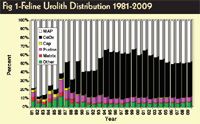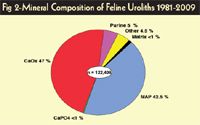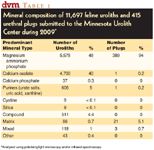Epidemiology of feline uroliths and urethral plugs: Update 1981 to 2009
In the last three decades, the composition of uroliths in cats has been variable, while the composition of feline urethral plugs has remained consistent.
In the last three decades, the composition of uroliths in cats has been variable, while the composition of feline urethral plugs has remained consistent. Here's a look at what may be causing this disparity and the implications for our feline patients.
Feline uroliths
In 1981, calcium oxalate was detected in only 2 percent of feline uroliths submitted to the Minnesota Urolith Center, whereas struvite was detected in 78 percent. However, beginning in the mid-1980s, a rapid, substantial increase in the frequency of calcium oxalate uroliths occurred in association with a reciprocal decrease in the frequency of struvite uroliths (Figure 1).

Figure 1: MAP = Magnesium ammonium phosphate, or struvite; CaOx = calcium oxalate; Cap = calcium phosphate.
From 1994 to 2002, approximately 55 percent of the feline uroliths submitted to the Minnesota Urolith Center were composed of calcium oxalate, while only 33 percent were composed of struvite (Figures 1 and 2). During this period, the decline in appearance of naturally occurring struvite uroliths associated with a reciprocal increase in calcium oxalate uroliths may have been associated with: 1) the widespread use of a calculolytic diet designed to dissolve struvite uroliths, 2) modification of maintenance and prevention diets to minimize struvite crystalluria (some dietary risk factors that decrease the risk of struvite uroliths increase the risk of calcium oxalate uroliths), and 3) inconsistent follow-up evaluation of efficacy of dietary management protocols by urinalysis and radiography.

Figure 2: MAP = Magnesium ammonium phosphate, or struvite; CaOx = calcium oxalate; CaPO4 = calcium phosphate.
In 2003, the frequency of calcium oxalate uroliths declined to 47 percent, while the frequency of struvite uroliths increased to 42 percent (Figure 1). During 2004, the number of struvite uroliths (45 percent) submitted to the Minnesota Urolith Center nudged past those containing calcium oxalate (44 percent). In 2005, the number of struvite uroliths (48 percent) surpassed those containing calcium oxalate (41 percent) in frequency of occurrence (Figure 1).
Of 10,093 feline uroliths submitted to the Minnesota Urolith Center in 2006, 5,001 (50 percent) were struvite, and 3,914 (39 percent) were calcium oxalate. In 2007, of 11,174 uroliths submitted to the center, 5,432 (49 percent) were struvite, and 4,553 (41 percent) were calcium oxalate (Figure 2). In 2008, 49 percent were struvite, and 39 percent were calcium oxalate. In 2009, 48 percent were struvite, and 40 percent were calcium oxalate (Table 1).

Figure 3: MAP = Magnesium ammonium phosphate, or struvite; CaOx = calcium oxalate; Cap = calcium phosphate.
The decrease in occurrence of naturally occurring calcium oxalate uroliths during the past seven years may be associated with: 1) reformulation of adult maintenance diets to minimize risk factors for calcium oxalate crystalluria, 2) improvements in formulation of therapeutic diets designed to reduce risk factors for calcium oxalate uroliths, and 3) increased use of therapeutic diets designed to reduce risk factors for calcium oxalate uroliths. The increase in appearance of naturally occurring struvite uroliths during the past seven years may be associated with the reciprocal relationship between some dietary risk factors for calcium oxalate and struvite uroliths. For example, diets that reduce urine acidity and provide adequate quantities of magnesium appear to reduce the risk of calcium oxalate urolith formation but increase the risk of struvite (magnesium ammonium phosphate) urolith formation.

Figure 4: MAP = Magnesium ammonium phosphate, or struvite; CaOx = calcium oxalate; CaPO4 = calcium phosphate.
The sustained increase in occurrence of struvite uroliths from 2003 to 2009 may be associated with decreased use of diets designed to dissolve sterile struvite uroliths as a consequence of the significant increase in occurrence of calcium oxalate uroliths in the 1980s and 1990s. However, it is likely that most of the 5,578 struvite uroliths obtained from cats and submitted to the Minnesota Urolith Center in 2009 could have been readily dissolved in two to four weeks by feeding diets designed to promote formation of urine that is undersaturated with struvite (e.g., Prescription Diet c/d Multicare — Hill's Pet Nutrition).

Figure 5: Various types of struvite that may occur in cats: A and B - sterile urocystoliths; C - infection-induced urocystolith; D - matrix-struvite urethral plug.
Feline urethral plugs
Since 1981, struvite has consistently been the most common mineral in feline urethral plugs (Figures 3 through 5, Table 1). The prevalence of calcium oxalate in urethral plugs consistently has been infrequent (< 1 percent). For example, 645 urethral plugs were submitted to the Minnesota Urolith Center in 2003. The mineral composition of approximately 87 percent of the plugs was primarily struvite (Figure 3). Less than 1 percent were composed of calcium oxalate.

Table 1: Mineral composition of 11,697 feline uroliths and 415 urethral plugs submitted to the Minnesota Urolith Center during 2009*
The explanation as to why there have been significant shifts in the prevalence of calcium oxalate and struvite in feline uroliths during the past 25 years, while the prevalence of struvite and calcium oxalate in feline urethral plugs has not significantly changed, is not obvious to us. Whatever the reasons, the dominant presence of struvite in urethral plugs is of clinical significance in terms of selection and timing of dietary strategies to prevent their formation.
Future research
Continued study and research are necessary to identify and monitor ongoing or new trends. Veterinarians are encouraged to send all uroliths and urethral plugs to the Minnesota Urolith Center for analysis and inclusion in epidemiologic investigations.
With the support of an educational gift from Hill's Pet Nutrition, the Minnesota Urolith Center is providing quantitative urolith analysis at no charge. Online submission, e-mail notification and electronic retrieval of results are available. With a database of more than 600,000 samples, the veterinary community is offered the latest information on urolith trends, treatment and prevention suggestions. For details, visit the center's Web site at www.cvm.umn.edu.
Dr. Osborne, a diplomate of the American College of Veterinary Internal Medicine, is professor of medicine in the Department of Small Animal Clinical Sciences, College of Veterinary Medicine, University of Minnesota.